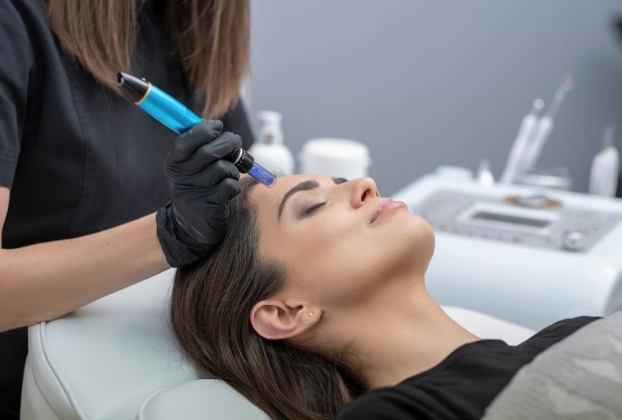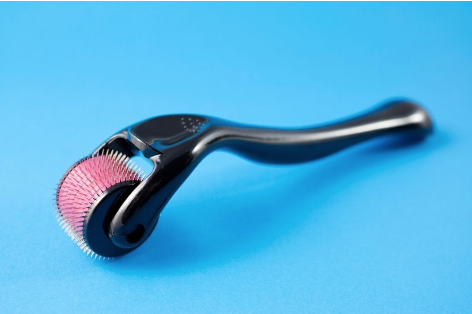|
Skin needling is one of the best skin treatments available on the market today. It helps to treat almost every skin concern from acne to aging to pigmentation. However, not all types of needling are created equal and the difference between an at home dermal roller and an in-clinic high-oscillating needling pen, can make an exponential difference in the health of your skin and the outcome of the treatment. Even though at home dermal rollers might sound like the best thing since sliced bread; they may not be all they’re cracked up to be. Various factors such as the ability to change the needle depth, mechanical action of the device, ability to sterilise or dispose of equipment, as well as education and understanding of the procedure, it’s interaction with the skin and aftercare, are the main differences between an at home dermal roller and an in-clinic needling pen. These differences make a huge impact to the quality of your results and the overall success of your treatment. While dermal rolling sounds like a fabulous, cheaper alternative for giving yourself at a home needling treatment, it truly can’t be compared with an in-clinic procedure. The mechanical aspects of dermal rolling vs. an in-clinic needling pen are very different. Dermal rollers come equipped with hundreds of tiny needles at a set length which are then rolled over the skin, whereas an in-clinic needling pen punctures the skin extremely fast in a stamping-like motion. The pen is then moved over the skin and the needle length/depth can be adjusted immediately during the treatment. The ability to adjust the needle length is crucially important to safely treating the skin and maximising the results of the treatment and is one of the main differences between the two methods. The deeper the needles used in skin needling also increases the risk of damaging the skin, especially if the treatment is performed by a non-qualified therapist. Since many dermal rollers are sold for private use at home, they’re normally created with a shallower needle depth of only around 0.25mm in order to make them safer to use for someone who is not a professional. However, this means they may not be suitable for treating some skin concerns. Different skin concerns are needed to be treated at different needle lengths, for example acne can be treated at a shallower needle depth since this condition when not severe, and if scarring is not being treated, only effects the top layers of the skin. However, if you wanted to increase collagen production and decrease the signs of aging or scarring then you would need to treat the skin at a greater depth puncturing into the dermis in order to get the results desired, this also normally results in pinpoint bleeding. This information is typically only known by a qualified therapist and is crucial to be aware of in order to figure out the most effective way to treat your skin. Areas of the face also need to be treated at different needle depths. Depending on how much bone is under the skin or how thin the skin is will determine the maximum needle depth safe for that area. Sensitive areas such as the forehead, under eyes, nose and top lip are generally treated with a more superficial needle depth. Parts of the face like the cheeks and neck, however, can be treated at a deeper needle depth and be treated more intensely. The ability to change the needle depth allows the therapist to treat the skin in the most effective yet safest manner possible and get the best results out of your treatment. Dermal rolling particularly can also cause excess trauma to the skin. The physical motion of rolling over the skin causes micro tears which can encourage excess bleeding and so, create unnecessary trauma. When an in-clinic needling pen is used, it only punctures the skin in a vertical manner which doesn’t create the micro tears seen with dermal rollers and minimises the trauma to the skin. There is also a massively larger risk of causing infections to the skin when performing an at home dermal rolling treatment vs having a skin needling treatment in-clinic. “No way!” you say, “I make sure my roller is clean.” Well unfortunately even though you might feel like your derma-roller is sterile at home I can assure you, it’s not. Unless you buy a new one every single time you use it and that new roller comes pre-packaged in sterile wrapping there will still be millions of bacteria lurking on the surface of the needles. Not even washing a derma-roller after use or wiping it clean with an alcohol swab does the job properly. Just think about it, you’re about to create hundreds of puncture wounds on your skin, do you really want to be doing that with a tool that is harbouring millions of bacteria and pathogens? Further to this, if your roller has larger needles and creates bleeding, that roller is now contaminated with human bodily fluids and should be disposed of since it now poses a risk to others if they were to touch it or get pricked by the contaminated needles. And don’t get me started on sharing dermal rollers between multiple people, honestly all I can say is yuck! You would never let a doctor give you an injection using a dirty reused needle, would you? So why do we do it to our faces? Using a needling pen in the clinic means that the therapist can open a new, sterile needling tip every time you come in for a treatment. There tips are never reused and disposed of as soon as the treatment is finished. This decreases the risk of infection exponentially and is extremely important to the procedure of the treatment its self. This is one of the most important differences between an in-clinic needling pen and an at-home needling roller and truthfully, I know which one I would prefer. There is no way I would ever have an invasive treatment that creates a wound on the body that doesn’t use sterile equipment! (This includes waxing too but that’s a whole other conversation). While it might not seem like much when you compare it to other procedures like surgery for example, skin needling still does create micro-wounds on the skin and has specific after care which must be followed in order to prevent infection, encapsulation or other skin conditions from developing. Using particular products after skin needling such as vitamin a, exfoliants, comedogenic ingredients and some other active ingredients can create irritation, inflammation and may damage the skin. This can cause breakouts, infections, itching, redness, pain and a whole host of other nasties. Doing dermal rolling at home can increase the risk of adverse reactions and knowing what’s safe and what isn’t to use on your skin after needling should be left to your trained therapist. - Skin x
0 Comments
Leave a Reply. |
Archives
June 2023
Categories |
SKIN GERALDTON |
QUICK LINKS |




 RSS Feed
RSS Feed

